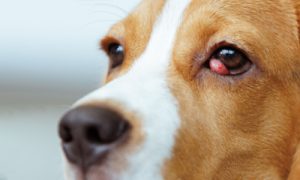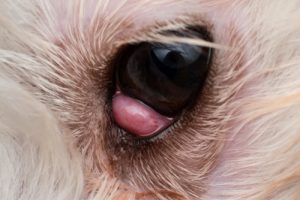Cherry eye is a common eye condition in dogs. It appears as a smooth pink or red swelling in the inside corner of the eye. It’s most common in young dogs under a year old and in certain breeds.
Summary:
Cherry eye often looks worse than it is. The swelling is a tear gland that’s popped out in the wrong place. Cherry eye isn’t painful but the swollen gland can get irritated and inflamed if untreated. It may come and go to begin with but usually needs surgery. A short operation can return the gland to the right place and secure it there.

Overview
What is cherry eye in dogs?
Dogs have three eyelids, unlike humans, who have only two. The third eyelid is hidden in the corner of the eye. It’s almost invisible when your dog’s eye is open. When your dog blinks, the third eyelid moves over the eye and spreads tears across it. This helps keep the clear part of the eye (the cornea) moist, and helps to remove dust and other small irritants.The third eyelid also has a gland that produces tears.
But the attachment of the gland to the third eyelid is very loose. Cherry eye happens when the third eyelid tear gland pops out from the underside of the third eyelid.
- The misplaced (prolapsed) gland appears as a pink swelling
- The cherry eye may come and go at first, but usually needs treatment eventually
- Over time, the exposed gland gets swollen and irritated
- Rubbing causes more irritation and damage
- Infection becomes a risk
- The eye may become dry if the gland can’t produce tears any more.

Symptoms
Symptoms of cherry eye in dogs
Cherry eye is easy to spot when it happens. You can see the prolapsed gland as a lump. It can look like a small cherry in the corner of the eye. That’s how it gets its name.
- Cherry eye appears suddenly as a red lump in the corner of one or both eyes
- It may not bother your dog at first
- Over a few days your dog starts to paw or rub at the eye
- Inflammation and infection make the swelling redder and bigger
- Greenish or yellow discharge happens when infection develops
Risk
Are some dogs more at risk of getting cherry eye?
Cherry eye is most common in the following groups:
Young dogs under a year old
Certain breeds including:
- Brachycephalic (short nosed) breeds like Pug, French Bulldog, English Bulldog, ShihTzu, Lhasa Apso, Pekinese
- Cocker Spaniel
- Poodle
- Beagle
- Newfoundland
- Great Dane
- St Bernard
This suggests cherry eye may be a genetic or inherited problem in some breeds or families of dog.
Are my family or other pets at risk of cherry eye?
- Cherry eye is not infectious. It won’t spread between animals or from animals to humans
- Other pets belonging to a susceptible breed may also get cherry eye
- The condition is inherited. So the risk may be greater for litter mates or puppies of affected dogs
Diagnosis
How is cherry eye diagnosed?
Vets can diagnose cherry eye by its distinctive appearance.
They may also carry out some additional test to check for:
Dry eye: resulting from damage to the prolapsed tear gland.
- The Schirmer tear test is a simple test to check tear production: placing a special indicator paper on the eye surface.
Scratches or ulcers on the cornea (the clear ‘window’ surface of the eye): resulting from rubbing or pawing an uncomfortable eye
- Fluorescein dye test: a drop of safe dye instilled in the eye. Ulcers or scratches show up bright green when they pick up the special dye. This test also shows whether tears can flow from the eye through a channel to the back of the nose, the tear duct. If the channel is open, green dye appears at the nostrils.
Vet treatment
How do vets treat cherry eye?
Treatment for cherry eye is surgical. It means small operation:
- Returning the gland to its proper position
- Creating a small pocket in the third eyelid to tuck the gland in safely
- Securing the gland in its pocket with dissolvable stitches
The cost for surgery in the UK will vary depending on the practice, location and any complications affecting surgery. It will include daycare, general anaesthetic for the operation and the operation itself.
Sometimes it’s possible to massage the tear gland back into position if this is done soon after it pops out and before it gets dry or swollen. However, recurrence is so common that this is not offered as an effective treatment option.
Home treatment
Home care for a dog with cherry eye
There are no home remedies or cures for cherry eye.
Until your dog has the operation, and during recovery:
- Keep the eye surface clean
- Gently bathe twice daily with cooled boiled water and a clean cotton pad
- Keep the eye moist: apply an eye lubricating ointment or gel 1-4 times per day to help prevent damage (for example, Viskyal, Lubrithal, Lacrilube)
- Use a cone collar to prevent damage from scratching or rubbing.
- Keep to lead exercise and avoid walking in dusty or windy conditions.
Prevention
Can cherry eye be prevented?
We can’t prevent cherry eye. It’s likely to be a risk from birth.
Ideally, avoid breeding from dogs with cherry eye.
When to worry
When should you be worried about cherry eye?
Cherry eye is not itself painful or dangerous. However, if untreated, complications can be serious and result from infection, severe inflammation or dry eye.
Call a vet as soon as possible if your dog is:
- Showing signs of pain and/or infection
- Keeping the eye closed
- Dull or depressed, not interested in usual activities
- Not eating
- Developing a green discharge from the eye
- Developing a sticky grey or green discharge on the eye surface
Joii can help with advice on:
- Identifying cherry eye
- Caring for a dog after eye surgery
- Cleaning your dog’s eyes
- Treating simple eye conditions at home, where appropriate








